The original intent for Furui Hanmā II was to cover all the Orient, Nippon and Cathay material produced for Warhammer in 1984, however there is really too much material to do any kind of justice to in just one blogpost, so this has once again been split into future posts. I also made a quick banner for these posts, based on the Oriental Heroes logo (which we'll get to eventually) and featuring Two Dragons in Clouds by Kanō Hōgai...
 |
| Furui Hanma Banner |
Now read on...
The Men of the Orient
While a couple of Samurai do appear in Warhammer 1st Edition Tabletop Battles book in artwork taken from an earlier flyer they not given any separate rules game-wise than any other kind of human in armour with a sword, they are fairly generic warriors, in eastern garb, fighting Orcs, which by the 1980s had become a generic western fantasy genre trope of evil.
All that changes with the publication of the Forces of Fantasy (1984) supplement. The East-meets-West approach is abandoned and instead the fantasy humans based on different historical cultures are split up and given their own distinct geographical settings to exist within, and given statistics, profiles and special rules that differentiate them in gameplay terms. Forces of Fantasy makes the Samurai statistically the best fighters and archers, outclassing any other humanoid troop type in the game. Alongside the superior Samurai, there are the more mundane Ashigaru or foot soldiers.
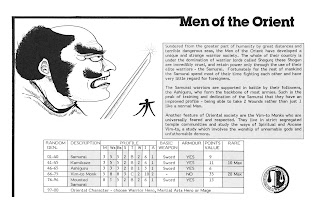 |
| Men of the Orient |
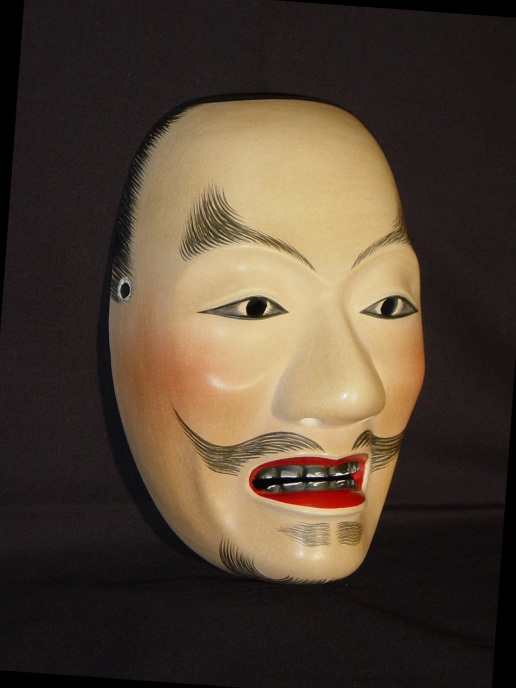 |
| Hieta Noh mask. |
Noh masks are found in traditional Japanese theatre, each mask expressing a specific character type that appears across multiple plays in the Noh genre, rather than depicting a single specific character. The Heita mask represents the idea of a mature, heroic, victorious warrior. His bushy eyebrows and ruddy complexion are due to the time spent on the battlefield, rather than at home plucking his brows and hiding from the sun.
Noh masks are extremely influential in Japanese character design beyond the theater, in comics and videogames, from Wario to Ogami Ittō, the Heita expresses a shared language of short-cuts that define characters that can be overlooked by western audiences. The choice here, in using Hieta to depict Oriental warriors seems completely accurate and culturally appropriate and goes some way towards integrating Japanese cultural ideas and visual language, into Warhammer rather than simply providing an image of a western ideal of the pseudo-medieval oriental warrior.
As well as the standard warrior-types, there are several specialist troops. The Kamikazee are obviously named after the suicide bombers of World War Two, and play as suicidal shock troops. These have nothing to do with the 16th century Japan that the Samurai are based on, and have no medieval historical origins. The Kamikazee are as clear an indication as any that the Men of the Orient are grounded in contemporary notions of the Oriental warrior, rather than an attempt to create a strictly historical fantasy.
Forces of Fantasy also introduces Vim-to Monks. For those readers who may be unfamiliar with British soft drinks that are extraordinarily popular in Arabian countries during Ramadan, Vimto is a mixed fruit flavoured beverage, sold as both a syrup and a carbonated drink. They do sweets as well. I assume "Vimto", being born in Manchester in 1908 and not having any particular relation to the far-east, or kung-fu, seems to have been chosen purely as a pun on "Shinto", the traditional religion of Japan.
This crude punning is somewhat essential to the early Warhammer experience, running throughout the names of Slann, Ogres, Halflings, and other humans, but is also displays a somewhat disrespectful attitude towards what is an important religion.
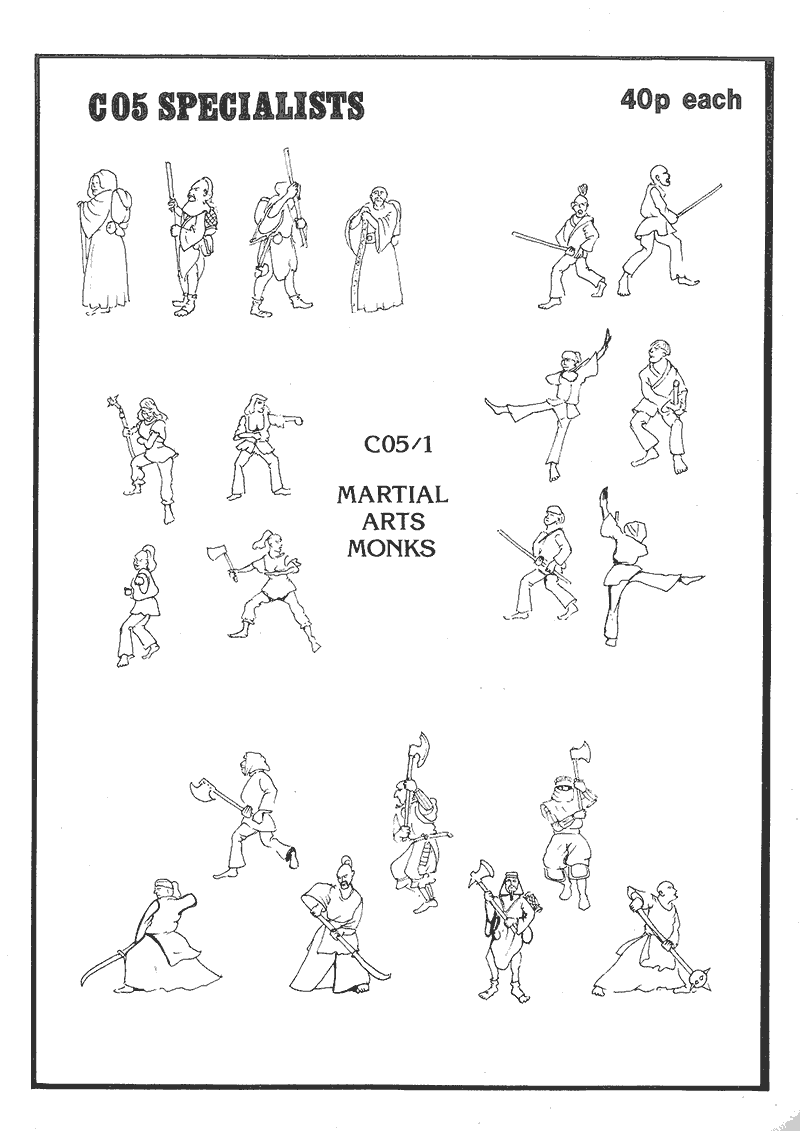 |
| C05 Specialists | Martial Arts Monks |
While Shaolin can be found in Japan - it crossed the sea from China to Japan in the 18th Century, like the Kamikazee reference this is quite a distance from the 16th Century Momoyama period of the Samurai and Ashigaru. As well as contracting historical periods, the Men of The Orient also collapses geography, combining both Japanese and Chinese forms, a vague concept of The East which blending, or ignoring, of the differences between Oriental cultures and history, strongly shaped by a Western lens rather than any attempt to create any kind authentic Eastern voice or a historically anchored basis from which to build the fantasy.
Forces of Fantasy also gives us a brief guide to the iconography of The Men of the Orient as might be found on their banners and other regalia. Alongside the mitsudomoe shinto symbol for Hachiman - the god of war and archery is the Heita Noh mask, both of which go some way to showing that, whilst wildly historically inaccurate, how well thought out and researched the iconography of the Men of the Orient is. One of the symbols in particular stands out - a rendition of the traditional Japanese manji 卍.
| Yurr dere's a swass sticker top left. |
 |
| Japanese Manji |
The symbol appears twice, both in the army list iconography and in the depiction of two oriental warriors.
 |
| Samurai Rising Sun and Mount Fuji motifs | John Blanche | Forces of Fantasy |
However, instead of the usual Japanese left-wards manji, Warhammer presents us with the right-wards turning version.
Of course, the symbol is more familiar to western audiences as the one appropriated by the Nazis from the Hindu to propagate the idea of Aryan racial supremacy, and is probably one of the most recognisable and reviled visual symbols in modern European history. There is no necessity for the use of the Swastika in Warhammer. It could easily have been avoided in favour of more obviously Eastern symbols like the yin-yang or any number of Japanese family crests (or mon), but given that it appears twice, and both the Noh Mask and mitsudomoe show some research was undertaken, it's hard to write off the swastika as a mere accident or casual historical reference.
 |
| various mon or family crests. |
There are number of possible readings of the Warhammer Oriental Swastika, none of which are exclusive to the others.
The Warhammer Oriental Swastika, could be a reclaiming of the Swastika symbol as a Manji or Kamon - the symbol is being deliberately re-aligned away from its association with Nazism and Aryanism, and placed into an previous historical context as an act of semiotic disarmament, robbing the symbol of it's specific power in singular political context, a form of genericide, where a symbol is shown to be so generic that any claims for specific use become ludicrous, and any flag-worshipping power the symbol might have for those gathered under its banner diminished. There have been periodic attempts at reclaiming the swastika over the years and are generally frowned upon as being 'epic fails' or worse, attempting to normalise the agenda the symbol has come to represent. The symbol itself has no intrinsic value, it's just some geometry, it is purely the narratives that surround it and its repeated use within specific contexts that form meanings, and while signifiers do shift, escaping the weight of history is not something that happens easily.
Then there is a 'punk' repurposing of the Swastika as pure agitprop (in a literal sense of 'agitating propaganda') the symbol only used in it's intent to shock and offend, as instigated by the prime punk provocateur, incidently of Jewish decent - Malcom McLaren, and carried out by future Queen of the Goths and Bromley Contigent superstar Siouxie Sioux.
 |
| Siouxie Sioux 1976 | Caroline Coons |via |
Notably Siouxie herself is no stranger to Orientalism, with the lyrics of The Banshees debut single, Hong Kong Garden, released in 1978 ostensibly being inspired by her local Chinese staff takeaway being abused by gangs of neo-nazi skinheads. The song is by no means unproblematical lyrically, celebration and condemnation ring out alongside crude stereotypes and witty rhymes in something of a stream of consciousness embracing all things Chinese, and there are later forays into 80s Japanomania.
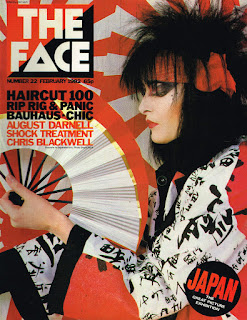 |
| Siouxie 1982 | Sheila Rock | The Face | |
 |
| Siouxie Sioux Hannya Noh Mask / Onibaba T-shirt | Rabatu Smitu | 1982? |
Similarly we could look to David Bowies Thin White Duke persona flirting with fascistic imagery and Orientalism:
Visions of swastikas in my head,
Plans for everyone
It's in the whites of my eyes,
My little China girl
David Bowie - China Girl 1983Oldhammerists often talk about the influences of 80s popular culture on Warhammer in a vague way, as if the statement itself provides validation of some innate quality, or that locating something in time is the same thing as explaining it. In Warhammers appropriation of the Swastika / manji in a Japanese context as the Warhammer Oriental Swastika, clear parallels can be drawn with sifting of post-war cultural detritus and ambiguous play as performed by eclectic post-punk magpies Siouxie and Bowie. Whether Bowie or Siouxies entanglement of the orient and fascism directly inspired Blanch or Priestly or Halliwell, or not, they are part of a broader cultural milieu superficially adopting the appearance of the rejected (fascistic) and exotic (oriental) as a performative, creative strategy, pushing against and challenging the mainstream consensus culture.
 |
| The Tale of Sanyo Kawasaki | Book of Batallions |
The Warhammer Oriental Swastika can be read as a reference to the Japanese role as one of the Axis powers allied to the Nazis in WW2, as a kind of 'honorary aryan' proxy-nazi. We already have the Kamikaze which establishes Warhammers Men of the Orient as being based on as much post-war stereotypes of Oriental as medieval stereotypes, and this is a further continuation of a post-war influenced theme, rather than a pseudo-medieval one. Then The Book of Batallions which appears in Forces of Fantasy describes Sanyo Kawasaki (named after a well known Japanese electronics and motorcycle company, respectively) - who feels his government is 'weak and liberal' and besieges their capital city for not sinking a 'foreign' ship on sight, a cartoon of a strident insular ultra-fascist, who is ultimately made ridiculous by committing ritual suicide by standing upside down in a bucket of cold water. The combination of anti-liberalism and violent xenophobia with the Swastika leaves very little room for doubt of what ideology is being pointed at in the character of Sanyo Kawasaki.
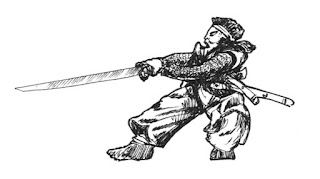 |
| Samurai | Sanyo Kawasaki (?) | Forces of Fantasy |
I will insert a break here, just to point out that Evan Webber, in the comments below, notes that the Tale of Sanyo Kawasaki closely follows the story of Yukio Mishima actor, author and militant Japanese nationalist who committed ritual suicide in 1970. The time-frame certainly puts these events within reach of the authors of Warhammer. and reframes the narrative as near contemporary satire, and puts paid to the idea the Orientalist conception of Nippon was born from ignorance or off-handed.
It should also be noted the Tale of Sanyo Kawasaki only describes one clan, or one faction, by no means are all Men of the Orient, nor even the dominant clans, portrayed as fascistic - this certainly wouldn't be the last time Warhammer attempted a cartoon of fascism.




Do you think illustrators put as much thought into their work as you put into deconstructing 35 year old pictures? Was it just an extension of naughty boys drawing symbols on their school books? Or were they looking for people to question them so they could throw their superior knowledge of the orient in the complainants face? Great article.
ReplyDeleteYeah, I don't know. I suppose you could ask John Blanche if he remembers if he thought much about it or was just indulging in some 'naughty schoolboy' antics, although I think he'd finished art college by then. As I say in the article, the wholly appropriate use of the mitsudomoe symbol and Noh mask would suggest some effort was put in, and unlikely to be mere coincidence. There are more goings on in 1984, that do make it look like the studio were on a bit of a Japanomania research binge.
ReplyDeleteAt the end of the day, to me it doesn't really matter if it was the end product of rational thought, subconscious bias or grabbing the first book of Japanese art history off the shelf and cribbing random stuff down out of it, the work itself still carries the same meanings. Glad you liked it.
It would perhaps have been better -- although not by much! -- if the Vim-To Monks had gained strength, Asterix-style, from downing magical purple potions. It wouldn't be any more accurate, but at least it would help explain the horrible pun.
ReplyDeleteYeah, I think most of the punning in Warhammer is really just one-dimensional, part of the irreverent attitude, which when combined with the occasionally excruciating attention to detail gives the whole thing a nerdy 6th form common room banter appeal.
DeleteVimto Asterix-potions reminds me of that Gorilla who escaped from London Zoo and went on a Ribena binge. Fizzy drink cults are definitely cool.
Great article. The Sanyo Kawasaki narrative also sounds like a Warhammerized last-days-of-Yukio Mishima; I imagine that his tale would have had some pull around the early studio set.
ReplyDeleteVery good catch. The story of Sanyo Kawasaki does seem to parallel that of Yukio Mishima. I hadn't considered more recent Japanese history to have been an influence, but it makes a lot of sense. It's a shame the Book of Battalions (I think collated by Richard Halliwell) doesn't say whose armies are whose.
DeleteI had no idea when I named my Knight House "Phantos" (after Fanta, because they're in Ryza orange) that I was continuing a long-running GW tradition!
ReplyDeleteThat's awesome.
DeleteI've long dreamed of recreating the Horus Heresy / Adeptus Titanicus as the Cola Wars, with Coke vs. Pepsi. Scratchbuilding the mecha out of actual cans. Not enough hours in the day.